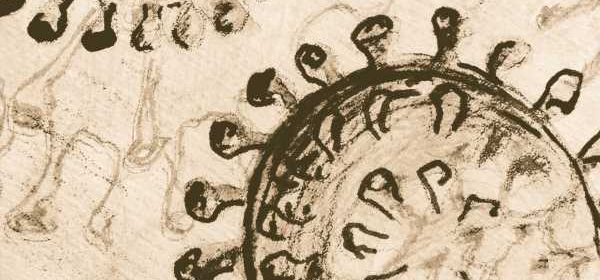An ancient coronavirus swept across East Asia 25,000 years ago

An ancient coronavirus may have infected the ancestors of people living in modern-day East Asia starting 25,000 years ago and for millennia afterward, according to a new study.
The COVID-19 pandemic, which has now claimed more than 3 million lives, has revealed just how vulnerable we are to new viruses. But as new as this threat seems, humans have been battling dangerous viruses since the beginning of time.
“There have always been viruses infecting human populations,” said senior study author David Enard, an assistant professor of ecology and evolution at the University of Arizona. “Viruses are really one of the main drivers of natural selection in human genomes.”
That’s because genes that increase people’s chances of surviving pathogens are more likely to be passed on to new generations.
Using modern-day tools, researchers can detect the fingerprints of these ancient pathogens — by pinpointing how they drove natural selection — in the DNA of people living today. This information, in turn, could provide valuable insight to help predict future pandemics, Enard told Live Science. “It is almost always true that things that occurred often in the past are more likely to occur again in the future.”
Using information available in a public database, Enard and his team analyzed the genomes of 2,504 people across 26 different human populations around the world. The findings, which have not yet been peer-reviewed, were posted Jan. 13 to the preprint database bioRxiv, and the study is in the process of being reviewed for publication in a scientific journal.
When coronaviruses slip inside human cells, they hijack the cells’ machinery in order to replicate. That means that a virus’ success depends on its interactions with hundreds of different human proteins. The researchers zoomed in on a set of 420 human proteins known to interact with coronaviruses, 332 of which interact with SARS-CoV-2, the virus that causes COVID-19. Most of these proteins help the virus to replicate inside the cells, but some help the cell fight off the virus.
The genes that code for those proteins constantly and randomly mutate, but if a mutation gives a gene an advantage — such as a better ability to fight off a virus — it will have a better chance of being passed down to the next generation, or selected for.
Indeed, the researchers found that in people of East Asian descent, certain genes known to interact with coronaviruses had been selected for. In other words, over time, certain variants appeared more frequently than would be expected by chance. This set of mutations likely helped the ancestors of this population become more resistant to the ancient virus by altering how much of these proteins were made by cells.
The researchers found that gene variants that coded for 42 of the 420 proteins they analyzed started to increase in frequency around 25,000 years ago. and the spread of advantageous variants continued until about 5,000 years ago, suggesting that the ancient virus continued to threaten these populations for a long time.
Unknown protection
“Viruses exert some of the strongest selective pressures on humans to adapt, and coronaviruses have presumably been around for a long time before humans existed,” said Joel Wertheim, an associate professor in the Department of Medicine at the University of California, San Diego who was not a part of the study. “So although it is not unexpected that coronaviruses would have driven adaptation in humans, this study presents a fascinating investigation into how and when this played out.”
Still, “it’s very difficult to say whether or not the virus that caused this evolution was also a coronavirus, but it seems like a plausible working theory,” Wertheim told Live Science in an email.
Enard agreed that the ancient pathogen that plagued our ancestors might not have been a coronavirus; instead, it may have been another type of virus that happened to interact with human cells the same way coronaviruses do.
Another group of researchers recently found that sarbecoviruses, the family of coronaviruses that includes SARS-CoV-2, first evolved 23,500 years ago, around the same time as variants in genes that code for coronavirus-associated proteins first emerged in people. The sarbecovirus findings were also posted as a preprint in bioRxiv, on Feb. 9, and have not yet been peer-reviewed.
That second study provides a “neat” confirmation for the whole story, Enard said.
Though the findings are intriguing, they don’t change our understanding of which populations are better at surviving SARS-CoV-2 infections, Enard said. There’s no evidence that these ancient gene adaptations help protect modern people from SARS-CoV-2. In fact, it’s “almost impossible to make these kinds of claims,” Enard said.
—11 (sometimes) deadly diseases that hopped across species
—14 coronavirus myths busted by science
—The 12 deadliest viruses on Earth
Rather, social and economic factors, such as access to health care, likely play a much larger role than genes in who gets sick with COVID-19, he added.
Enard and his team now hope to collaborate with virologists to understand how these adaptations helped ancient humans survive exposure to this primeval coronavirus. The team also hopes that eventually such ancient genome studies can be used as an “early warning system” for future pandemics. For example, researchers can first survey for viruses in the wild that haven’t yet infected human populations and then look for their fingerprints in human DNA. If they find that a virus has caused many ancient epidemics, it could be good reason to keep a close watch on it, Enard said.
Though we see glimpses of the impact of this ancient virus on people’s ancestors, future generations will likely not be able to see the traces of SARS-CoV-2 in our genome, Enard added. Thanks to vaccination, the virus won’t have time to drive evolutionary adaptation, he said.
Originally published on Live Science.
Source: Read Full Article